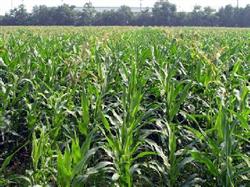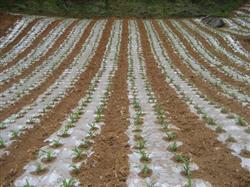The importance of getting rid of weeds in summer corn field

The growth of weeds in corn field is fast and concentrated, and when the soil moisture is good, about 10 days after sowing, the emergence rate of weeds reaches a peak, and the emergence rate reaches about 90% in 15 days. In case of rainfall or watering, there is a small peak of emergence in 4 days. When the plant is damaged by weeds at the seedling stage, the plant is short, thin and yellow, which will also aggravate the occurrence and harm of diseases and insect pests in the corn field, resulting in poor growth and yield decline in the middle and later stage, which is an important factor restricting the high yield of maize. Chemical control: the main herbicides used in the stem and leaf treatment of maize seedlings were stem and leaf treatment agents. The best time for weeding after seedling is 5-7 leaf stage of maize (2-3 leaf stage of weeds), when the weeds are full, the resistance of corn is high, and the drug damage is not easy to occur. Herbicides can be selected as nicosine atrazine, nicosulfuron, oxazolone, etc., and 52% nicosulfuron wettable powder 60 g per mu plus 40 ml of water 30 kg for stem and leaf spray. At 4-6 leaf stage or a few days later, interrow protective application and directional spraying were used to control all weeds in corn field. The insecticide is selected as the sterilizing contact type stem and leaf treatment agent, which can be sprayed with 20% paraquat 200ml / mu or 20g 100-120ml / mu without trace. Do not spray on corn leaves when using, and spray evenly at the same time. Matters needing attention 1. Correct selection of corn herbicides according to the types of weeds in the corn field, combined with the method of use, choose and buy the right herbicides. 2. The correct application technology should be used to accurately calculate the dosage according to the area of corn field, and the spraying should be uniform, no re-spraying and no leakage. The sprayer nozzle had better use a fan-shaped sprinkler to make the liquid spray evenly. 3. Determine the dosage according to the soil moisture, the soil moisture is poor, and the land with higher wheat stubble should not only increase the water consumption, but also use the upper limit of the recommended dosage, but should not increase the dosage arbitrarily to avoid drug damage. In the case of poor soil moisture, we should pay attention to sprinkler irrigation in time after pesticide application. 4. According to the soil texture and the content of organic matter, the soil with fertile soil and high content of organic matter should be selected, and the high amount should be selected within the range of recommended amount of herbicide, while the low amount should be selected in the land with poor soil and low content of organic matter. 5. Choose the best time to apply the pesticide in the high temperature season in the seedling stage of corn, and the pesticide should be applied before 10 o'clock in the morning and after 4 o'clock in the afternoon, in order to reduce the volatilization of the liquid, benefit the absorption of soil and weed stems and leaves, and improve the weeding effect. In addition, the windy weather can not be applied to avoid foggy droplets, uneven application, reduce the efficacy, but also cause drug damage to other crops around.
- Prev

Operation and Research methods of phosphorus and potassium Fertilizer for High-yield Maize
The application effect of phosphorus and potassium fertilizer varies greatly due to the available content of soil. The application of phosphorus and potassium is beneficial to the early development of strong seedlings, strong plants and large ears, increase the ratio of grains to leaves, increase the number of grains and grain weight, which is an important condition to improve population quality. However, after the application of phosphorus and potassium fertilizer, most of it was absorbed and fixed by the soil, and the absorption and utilization rate was low in the soil.
- Next

Current management measures of spring sowing corn
1. Take measures according to local conditions and select improved varieties. Popularize Yedan 13, Xiyu 3, Huayu 4, Zhongdan 32, Chenghai 1 and Expedition 808 in plain and hilly areas. Yedan 22, Yedan 51 and 9362 with short stem and short growth period are selected for interplanting in cotton fields. Zhongnuo 1 can be planted in suburban areas.
Related
- The first cup of black tea in spring, the flavor and history of tea gardens in Kenya, Africa
- The computer can not only choose potatoes, but also grow tea rice. AI will grow winter oolong tea champion.
- It is not only the inflated tea bitten by insects, but also engraved with the four seasons tea in Beipu.
- The Oriental Beauty Tea Festival in Zhuxian County takes the stage at the weekend to experience the plus-size feast of oil tea.
- & quot; Oriental Beauty Tea & Exploration of Emei in Hsinchu, the hometown of quot;
- The new variety of strawberry "Tainong 1" dessert is the first choice with mellow aroma. Crimson gorgeous
- History of Tea in Taiwan: from Wild Inner Mountain to Export Tea Garden
- Two types of Taiwan Oriental Beauty Black Tea won the British three-Star Award for Childhood Tea Xiang Zhang Jiaqi changed from pilot to champion tea maker.
- Banana species and varieties: the planting history of Taiwan Xianren banana and dwarf banana is long, is banana disease resistant?
- Coffee planting Technology: Qianjie Coffee from Seedling to harvesting

